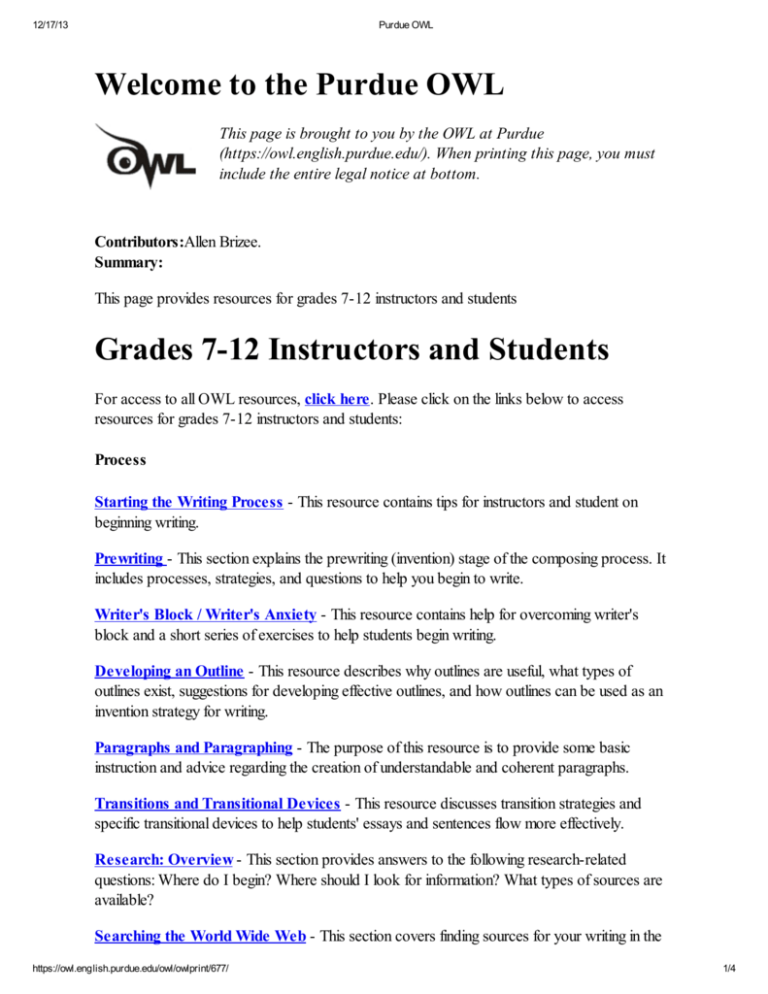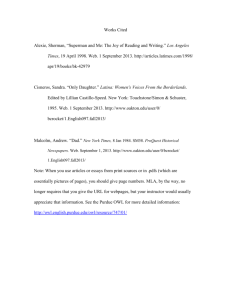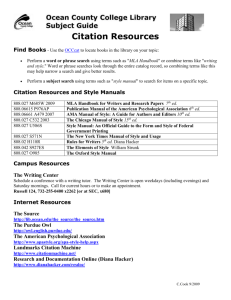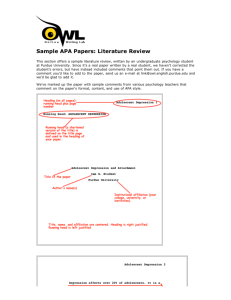Welcome to the Purdue OWL Grades 7
advertisement

12/17/13 Purdue OWL Welcome to the Purdue OWL This page is brought to you by the OWL at Purdue (https://owl.english.purdue.edu/). When printing this page, you must include the entire legal notice at bottom. Contributors:Allen Brizee. Summary: This page provides resources for grades 7-12 instructors and students Grades 7-12 Instructors and Students For access to all OWL resources, click here. Please click on the links below to access resources for grades 7-12 instructors and students: Process Starting the Writing Process - This resource contains tips for instructors and student on beginning writing. Prewriting - This section explains the prewriting (invention) stage of the composing process. It includes processes, strategies, and questions to help you begin to write. Writer's Block / Writer's Anxiety - This resource contains help for overcoming writer's block and a short series of exercises to help students begin writing. Developing an Outline - This resource describes why outlines are useful, what types of outlines exist, suggestions for developing effective outlines, and how outlines can be used as an invention strategy for writing. Paragraphs and Paragraphing - The purpose of this resource is to provide some basic instruction and advice regarding the creation of understandable and coherent paragraphs. Transitions and Transitional Devices - This resource discusses transition strategies and specific transitional devices to help students' essays and sentences flow more effectively. Research: Overview - This section provides answers to the following research-related questions: Where do I begin? Where should I look for information? What types of sources are available? Searching the World Wide Web - This section covers finding sources for your writing in the https://owl.english.purdue.edu/owl/owlprint/677/ 1/4 12/17/13 Purdue OWL World Wide Web. It includes information about search engines, Boolean operators, web directories, and the invisible web. It also includes an extensive, annotated links section. Evaluating Sources of Information - This section provides information on evaluating bibliographic citations, aspects of evaluation, reading evaluation, print vs. Internet sources, and evaluating internet sources. Quoting, Paraphrasing, and Summarizing - This resource will help you become more comfortable with the uses of and distinctions among quotations, paraphrases, and summaries. This handout compares and contrasts the three terms, gives some pointers, and includes a short excerpt that you can use to practice these skills. Avoiding Plagiarism - This resource offers advice on how to avoid plagiarism in your work— there are few intellectual offenses more serious than plagiarism in academic and professional contexts. Rhetoric and Logic Creating a Thesis Statement - This resource provides tips for creating a thesis statement and examples of different types of thesis statements. Establishing Arguments - This section discusses the thesis statement and explains argument in writing, which includes using research to support a thesis. This resources also discusses Aristotle's logical proof: ethos, pathos, and logos and the logical fallacies. Logic in Argumentative Writing - This resource covers logic within writing— logical vocabulary, logical fallacies, and other types of logos-based reasoning. Rhetorical Situation - This presentation is designed for instructors to use with students to introduce a variety of factors that contribute to strong, well-organiz ed writing. This presentation is suitable for the beginning of a composition course or the assignment of a writing project in any class. Different Kinds of Essay Genres Writing a Research Paper - This section provides detailed information about how to write research papers including discussing research papers as a genre, choosing topics, and finding sources. Writing About Fiction - This resource covers major topics relating to writing about fiction. This covers prewriting, close reading, thesis development, drafting, and common pitfalls to avoid. Writing About Literature - This material provides examples and description about writing papers in literature. It discusses research topics, how to begin to research, how to use information, and formatting. https://owl.english.purdue.edu/owl/owlprint/677/ 2/4 12/17/13 Purdue OWL Writing About Poetry - This section covers the basics of how to write about poetry. Including why it is done, what you should know, and what you can write about. Writing Definitions - This resource provides suggestions and examples for writing definitions. Style and Language Adding Emphasis in Writing - This handout provides information on visual and textual devices for adding emphasis to student writing including textual formatting, punctuation, sentence structure, and the arrangement of words. Conciseness - This resource explains the concept of concise writing and provides examples of how to ensure clear prose. Paramedic Method: A Lesson in Writing Concisely - This handout provides steps and exercises to eliminate wordiness at the sentence level. Sentence Variety - This resource presents methods for adding sentence variety and complexity to writing that may sound repetitive or boring. Sections are divided into general tips for varying structure, a discussion of sentence types, and specific parts of speech which can aid in sentence variety. Using Appropriate Language - This section covers some of the major issues with appropriate language use: levels of language formality, deceitful language and Euphemisms, slang and idiomatic expressions; using group-specific jargon; and biased/stereotypical language. Punctuation - This resource will help clarify when and how to use various marks of punctuation. When speaking, we can pause or change the tone of our voices to indicate emphasis. When writing, we must use punctuation to indicate these places of emphasis. Proofreading Your Writing - This section provides information on proofreading, finding and fixing common errors. Commas - This resource offers a number of pages about comma use. Citation Annotated Bibliography - This resource provides information about annotated bibliographies. MLA Formatting and Style Guide - This resource, updated to reflect the MLA Handbook for Writers of Research Papers (6th ed.) and the MLA Style Manual and Guide to Scholarly Publishing (2nd ed.), offers examples for the general format of MLA research papers, in-text citations, endnotes/footnotes, and the Works Cited page. MLA (Modern Language Association) style is most commonly used to write papers and cite sources within the liberal arts and humanities. APA Formatting and Style Guide - This resource, revised according to the 5th edition of the https://owl.english.purdue.edu/owl/owlprint/677/ 3/4 12/17/13 Purdue OWL APA manual, offers examples for the general format of APA research papers, in-text citations, endnotes/footnotes, and the reference page. APA (American Psychological Association) is most commonly used to cite sources within the social sciences. Writing and Research Help by Email - Still have questions about your writing? Haven't found what you need? Send us an email! Our staff will provide individualized writing help online. https://owl.english.purdue.edu/owl/owlprint/677/ 4/4



